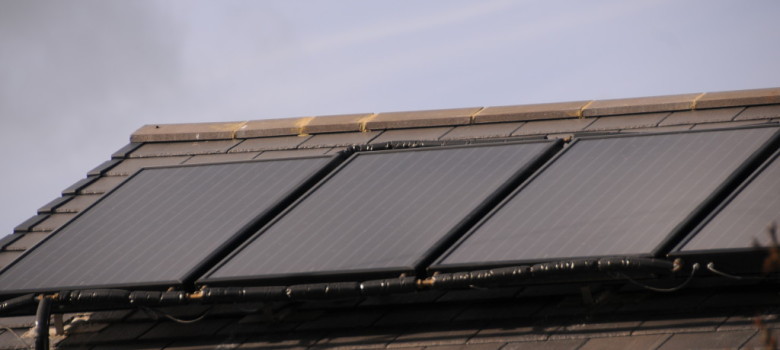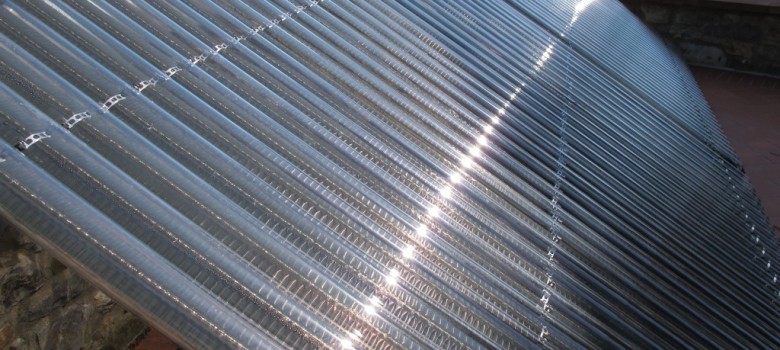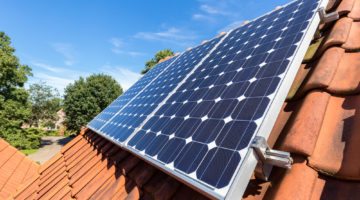
Want to produce both hot water and electricity from the sun?
You might want to consider installing Solar Photovoltaic-Thermal, or PV-T for short.
PV-T is a hybrid solar panel combining the functionality of solar thermal collectors and solar PV in one panel. The panels create not only electricity but also produce hot water for use in the home. Two functions from one investment!
 Hot solar PV panels produce less electricity
Hot solar PV panels produce less electricity
Contrary to popular belief, solar PV panels actually work more efficiently in cold sunny weather. People often assume that hot sunny conditions are the best, but actually as solar PV panels get warmer, they become less efficient. In fact, for an average PV panel, each degree warmer the panel becomes, it will become around 0.5% less efficient. So in the UK, where the dark solar panels regularly hit 70-800c, this could mean a 25% decrease in efficiency at peak time.
>>> LEARN MORE ABOUT IMPACT OF TEMPERATURE ON SOLAR PANELS <<<
This is the reason why many solar installers will try to mount the solar panels on a frame which is slightly raised from the roof to ensure air can circulate around the unit to help keep it cool.
Bearing this in mind, the theory behind running both solar PV and solar thermal through the same panel is sound. The excess heat can be transferred from the solar PV-T panel via a heat exchanger located on the back of the panel and into heat transfer fluid that can used to heat the home.
So not only are you running the photovoltaic cells more efficiently since they are cooler, you are also contributing to your home’s hot water requirements.
Another key advantage of these Solar PV-T hybrid panels they take up less space on your roof. There is no longer the requirement to invest in separate panels to carry out the different functions which can look unsightly. One type of panel will produce both your hot water and electricity.
So what are the issues with solar PVT / Solar Hybrid Panels?
While solar PVT hybrid panels in principal are a fantastic idea, there are 3 major issues with them.
- Solar PVT panels should in theory allow you to benefit from both the feed-in tariff and the renewable heat incentive, since you are producing electricity and renewable heat. Having spoken to the Government teams responsible for these schemes (Aug 2014), in domestic situations they have confirmed that the PV-T hybrid solar panels in domestic installations will only benefit from the Feed-in tariff – not the RHI. However for Non-domestic Solar PV-T installations, one would be able to claim for both the FiT and the RHI. This does mean the payback period for domestic PV-T installations is longer although for commercial applications it still makes great financial sense. The fact that the Government has approved the double income for commercial suggests that it won’t be too long before this is extended to domestic installs too!
- Solar PVT panels are more expensive than the price of traditional solar PV panels. Having said that, Solar PV-T systems can be installed at almost the same cost as the equivalent capacity of separate PV and Solar thermal and so can be a sensible investment where roof space is tight. The PV-T panel is roughly 10% more expensive than the cost of an individual PV panel and solar thermal panel installation but 25% more efficient than the individual technologies. Manufacturers also hope as volume builds the panel costs will come down making them a cheaper option as opposed to the traditional alternative.
- The last issue with PV-T panels is that they produce the majority of the hot water and electricity in the summer months. In the winter months when you need a lot of hot water for space heating, the PV-T panels won’t produce enough hot water so you will need to supplement the heating with a boiler – this however is the same problem with solar thermal too! There are companies with a neat solution to this however, they use the summer heat to charge the ground and then use heat pumps to pull out and upgrade this heat in the winter. This keeps the panels cool in the summer, which maximises their output at the same time as increasing the source temperature for the heat pump in the winter making it run more efficiently.
Do Solar PVT Hybrid Panels have a future?
Yes of course! PV-T can add value even without the domestic RHI. There are a few companies now that offer PV-T hybrid solar panels therefore proofing the commercialisation of this technology is the future.
In time, PV-T panels will surely get the necessary paperwork to profit from the financial incentives like their commercial counterparts in turn boosting their popularity. And with this will come economies of scale which will see a drop in the price of installation. But don’t forgot even now PV-T panels are on a par with the equivalent separate PV and solar thermal system.













I have always wondered if this kind of panel existed – they seem like a very sensible idea as you suggested. If you were to look into your crystal ball, how long do you think it will take the Government to include the PVT panels in the FIT / RHI schemes?
Hi Siobhan, thanks for your comment!
To be honest I have no idea – I will put it to our contacts in DECC and see if they come back with anything.
Which companies install solar PVT please? I am very interested in this source of energy. Thanks
Hi Marian, not many in truth! Until they are applicable for both RHI and FIT then the companies are better off selling them separately since they are more cost effective for the clients.
Hi Siobhan, Marian and James,
If you are interested in these types of panels then we are one of the few companies in the country with access to fully accredited panels and the specialist design capabilities required to successfully deliver them.
Thank you
Minimise Generation – do you have a section on your site with more information? I can only find business orientated information on there and nothing that looks like it’s aimed at the public.
Hi Dave,
Is there something in particular you are looking for? Most of our site is aimed at domestic properties, although some articles are more for businesses.
I have got 9 panel space on my roof. Can only produce 2.25kw with normal panel. What is the best my space can get from your hybrid panels.
I have collected written information from many trade publications and company web sites that manufacture or promote PVT.
I started in solar water heating 25 years ago, starting with the design of a hot water tank that could deliver both hot water at mains pressure for domestic hot water needs and none pressure for space heating. This early designed hybrid hot water tank is now sold as a thermal store in the UK.
Unless the people promoting PVT understand the benifits of a thermal store and have wide experiance in all types of solar thermal collectors and systems as I have gone through, PVT in its present format and cost will never gain a wider market.
In the past 4 years i have invested $100,000 with American investors to develop a self assemble thermal cooling panel for any brand of PV panels in the global market.
The first testing will be carried out in Portland Maine, starting next month to take in the heavy snow fall this part of the USA see every year. The test will include snow melting as well as proving the performance diffrence between an array of PV and same size PVT
Our design and simplicty will allow solar PV panels to be cooled from $80.00 a panel + the thermal store and plumbing kit needed to complete the system, separate from that of the PV Kit
The failure of all PVT sold panels is they all follow what has been sold as a flat plate solar panel with a unvented pressure tank, while including support for heating which a standard hot water tank cannot deliver
Hello Mr Hawkins, I have been looking for exactly what you describe – a PVT conversion kit that can be applied to any solar panel. I am off grid in N. California and I would like to convert my existing array (4.5kw) into a PVT array but I do not want to buy new panels – I want to add a heat converter to the backside of my existing panels. Please tell me how I can get in touch with this project! I would test them! I can make a plumbing system. I was drawing up my own design for this kind of hybrid conversion, but I would much rather use what has already been created if it works good. I would make a purchase if they are ready, or even pay something to help test them. My summer temperatures are very hot (100f – 110’s for months sometimes) and I know I would see a great increase in kWH Production if I could cool my panels.
My region could be a great market for this and I am also open to becoming an installer. Please contact me!
-Ocean Littlefield
olittlef over at gmail
We are Very interested in sourcing effective PVT solutions for the UK market, please contact us at info@blackandgreen.org.UK with further info about your research/products. Regards: Mr Emmanuel +44 7939 056 667
We are the only UK manufacturer of PV-T panels and have numerous case studies an installations to back up the suitability of the technology. You can view our technical data section online if you wish to find out more behind the technology, including some performance charts comparing PV-T with PV and thermal in terms of carbon displacement per M2.
Hello,
i am from belgium and looking form pv-t but there is not mutch in belgium . Can you give me moe information about it ?
Email bartv76@gmail.com
thanks
Are the PVT panels available in the US, if so, where can I purchase them?
I am looking to heat my pool and generate electricity to offset my electric bill
My self Sujan from India, I need an industry contact who can fabricate PVT panels which can operate under 2-3X concentration in the required dimension (preferably 0.4m X 1 m).
What type of technology are you using in your PV-T panels? I’ve been looking at some hybrid c-Si/a-Si panels manufactured by Panasonic that claim impressive levels of efficiency.
there is another solution for the hot water and that is insulated storage tanks with a baffle system to separate the different water temps
The government will not support solar thermal or solar PVT in the long term, once the RHI ends in 2020, with PV FIT ending April 2019.
This is good news, as without goverment interference, prices will come down. We all need to look to investing in tax free energy, and the future is solar PVT combined with a thermal store and a ground source heat pump
Hi,
I need specifications and cost of PV thermal system. Please send me at umair.iqbal482@gmail.com.
Good afteroon, to reach EPC rating of B (currently C) my recommendation is to install both Solar PV and Solar Thermal panels, the house we are moving to only has a small south facing slope so ideally a hybrid panel could be optimal if positioned there, I am wondering if you supply to Devon and do you offer a hybrid panel or is it Solar PV alone? The house was built in 2006 by Barratt homes and has a thinner false slate effect tiling. Thanks for your time.